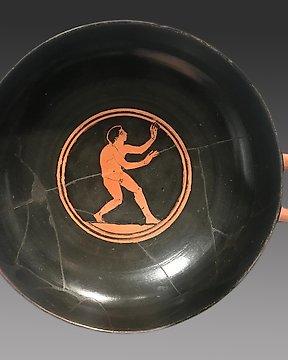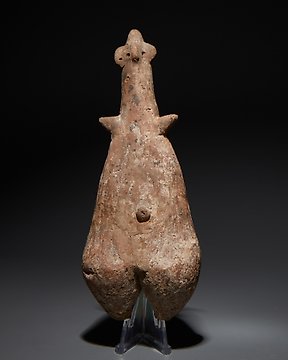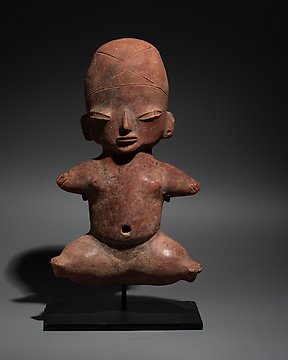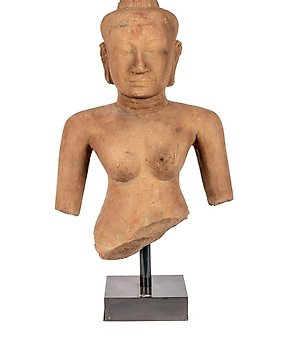Annoying quality of the item. I just threw it away.
Προβολή μετάφρασηςΦοινικικό Terracotta Ex-Voto ή Idol που απεικονίζει έναν Τρίτωνα. 6ος-4ος αιώνας π.Χ. 32 εκ. Υ. Παλαιάς προέλευσης.
Αρ. 85665229



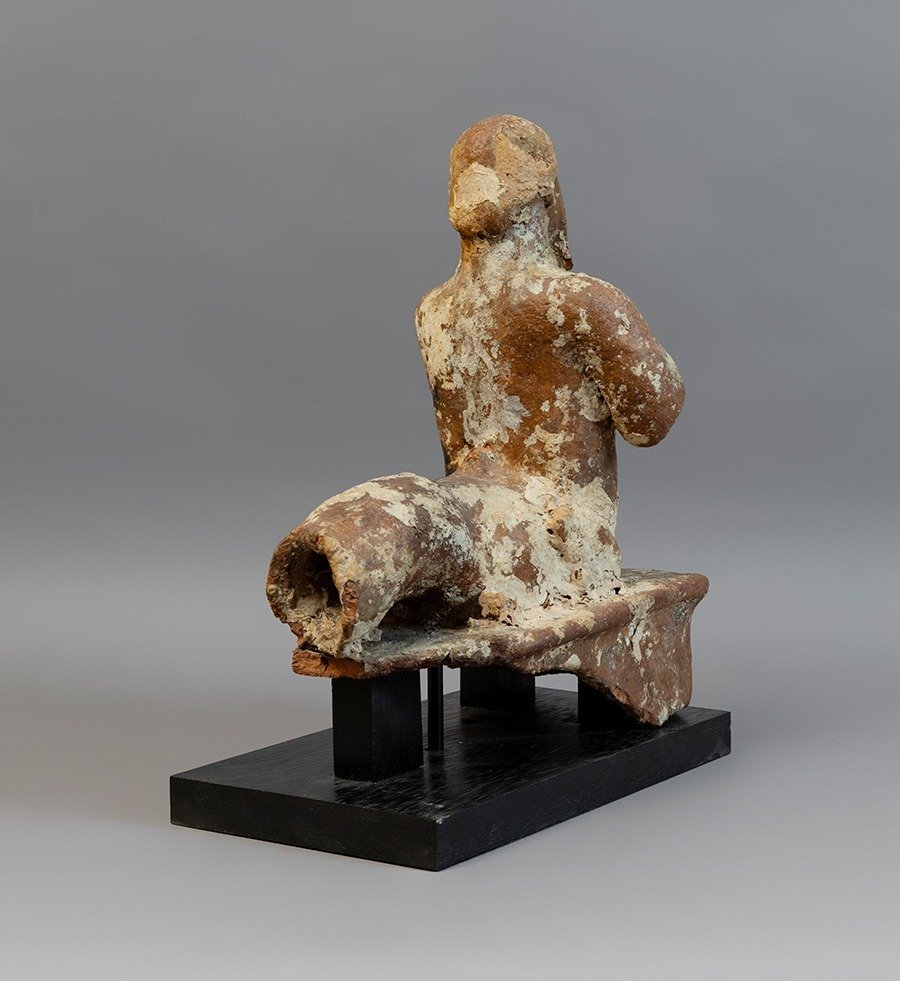

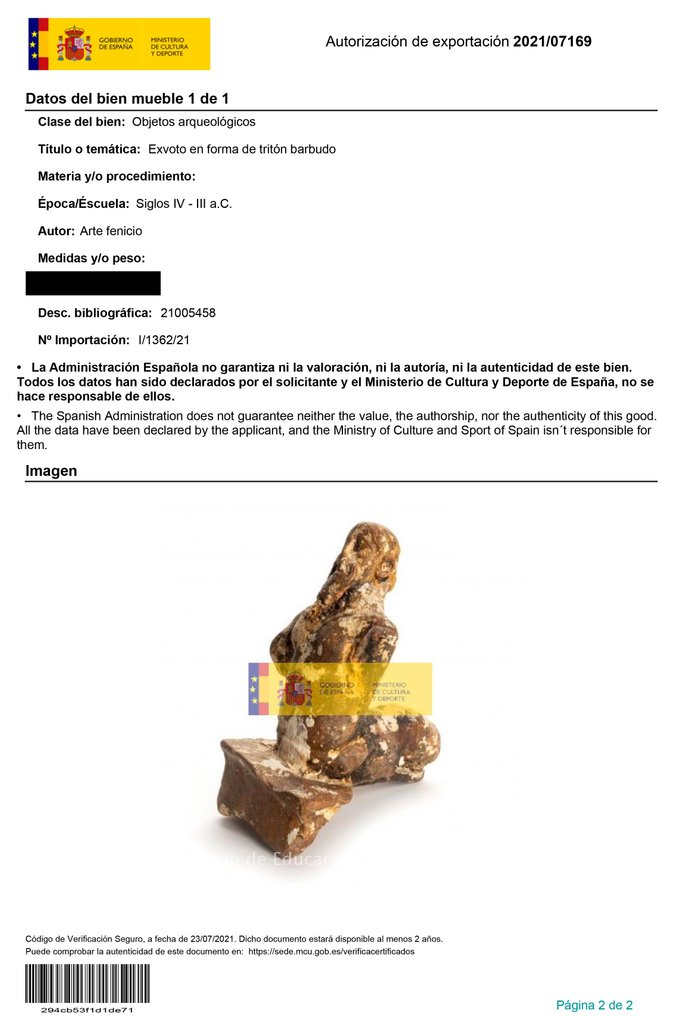
Important figure of an Ex-Voto or Idol depicting a Triton.
Phoenician, c. 6th - 4th century B.C.
32 cm H and 27 cm L. (without stand) 36 cm H with stand.
- STAND DISPLAY INCLUDED -
PROVENANCE: Maurice Druon Collection, Paris 1918 - 2009. Druon was a French writer and academic, Minister of Culture of France between 1973 and 1974.
CONDITION: Good state, see photos, unrestored.
DESCRIPCTION:
It is representing a Hybrid creature, the upper half being a man's body and lower half is a fish's body, specifically the tail.
It is presented on a base made in the form of an altar. The human torso is naked, with fine features such as the chest and the navel. The face has a serene expression with large almond shaped eyes highlighted by eyelids that are marked with a thick line, this being a Phoenician interpretation that is of clear Greek Archaïc inspiration.
At the height of the chin, there is a false beard, reminiscent of that used by the Egyptian pharaohs as a sign of power. The hair is worked in a smooth way, delimited in all its contour by a line of geometric design that frames the form of the man's head, this in turn links with the classic Greek tradition. In this way we can see how it is a piece that eclectically combines influences from styles such as Greek or Egyptian, the result of the Phoenicians' contacts with these cultures.
With respect to its iconography, it could be Yam, the god of the sea in the Canaanite pantheon. Yam is a deity of the sea and his palace is in the abyss associated with the depths. He represents the primordial chaos, the power of the sea, uncontainable and furious; he is seen as the god of dominant storms and the disasters they cause, and he was an important deity for the maritime Phoenicians.
This figure belongs to a group of Phoenician terracottas that remained 2,500 years under the sea until the 1960s when a fortuitous discovery made it possible to find all the pieces. One of the hypotheses that are being considered is that the Phoenicians, faced with the siege that the city suffered by Alexander the Great, loaded their ships with these pieces in order to escape from the city with their most precious goods. However, a storm must have surprised them a few kilometres from the coast, causing the ship to sink and the terracotta boats it contained to sink.
The sea god Triton, of Greek origin, is depicted on this Phoenician votive offering with a stylised face framed by a beard that gives him an aristocratic bearing. The muscular torso curves at the level of the hips, growing to the back with a long tail. He probably originally could have been blowing a conch shell. It follows Greek precepts in terms of representation, with the torso of a man and the lower part of a fish. Legend has it that Triton lived with his parents, Poseidon and Amphitrite, in a golden palace at the bottom of the sea. He is often depicted with a conch shell that he blows like a trumpet. The Phoenician culture, and later the Romans, inherited this figure and reinterpreted its symbolism. Here, adopting the role of an ex-vota, he gives good fortune to sailors.
Notes:
The seller guarantees that he acquired this piece according to all national and international laws related to the ownership of cultural property. Provenance statement seen by Catawiki.
The piece includes authenticity certificate.
The piece includes Spanish Export License.
THE MINISTRY OF CULTURE FROM SPAIN ASKS ALL SELLERS FOR INVOICES OR OTHER DOCUMENTATION ABLE TO PROVE THE LEGALITY OF EACH ITEM BEFORE PROVIDING AN IMPORT OR EXPORT LICENSE.
Ιστορία πωλητή
Important figure of an Ex-Voto or Idol depicting a Triton.
Phoenician, c. 6th - 4th century B.C.
32 cm H and 27 cm L. (without stand) 36 cm H with stand.
- STAND DISPLAY INCLUDED -
PROVENANCE: Maurice Druon Collection, Paris 1918 - 2009. Druon was a French writer and academic, Minister of Culture of France between 1973 and 1974.
CONDITION: Good state, see photos, unrestored.
DESCRIPCTION:
It is representing a Hybrid creature, the upper half being a man's body and lower half is a fish's body, specifically the tail.
It is presented on a base made in the form of an altar. The human torso is naked, with fine features such as the chest and the navel. The face has a serene expression with large almond shaped eyes highlighted by eyelids that are marked with a thick line, this being a Phoenician interpretation that is of clear Greek Archaïc inspiration.
At the height of the chin, there is a false beard, reminiscent of that used by the Egyptian pharaohs as a sign of power. The hair is worked in a smooth way, delimited in all its contour by a line of geometric design that frames the form of the man's head, this in turn links with the classic Greek tradition. In this way we can see how it is a piece that eclectically combines influences from styles such as Greek or Egyptian, the result of the Phoenicians' contacts with these cultures.
With respect to its iconography, it could be Yam, the god of the sea in the Canaanite pantheon. Yam is a deity of the sea and his palace is in the abyss associated with the depths. He represents the primordial chaos, the power of the sea, uncontainable and furious; he is seen as the god of dominant storms and the disasters they cause, and he was an important deity for the maritime Phoenicians.
This figure belongs to a group of Phoenician terracottas that remained 2,500 years under the sea until the 1960s when a fortuitous discovery made it possible to find all the pieces. One of the hypotheses that are being considered is that the Phoenicians, faced with the siege that the city suffered by Alexander the Great, loaded their ships with these pieces in order to escape from the city with their most precious goods. However, a storm must have surprised them a few kilometres from the coast, causing the ship to sink and the terracotta boats it contained to sink.
The sea god Triton, of Greek origin, is depicted on this Phoenician votive offering with a stylised face framed by a beard that gives him an aristocratic bearing. The muscular torso curves at the level of the hips, growing to the back with a long tail. He probably originally could have been blowing a conch shell. It follows Greek precepts in terms of representation, with the torso of a man and the lower part of a fish. Legend has it that Triton lived with his parents, Poseidon and Amphitrite, in a golden palace at the bottom of the sea. He is often depicted with a conch shell that he blows like a trumpet. The Phoenician culture, and later the Romans, inherited this figure and reinterpreted its symbolism. Here, adopting the role of an ex-vota, he gives good fortune to sailors.
Notes:
The seller guarantees that he acquired this piece according to all national and international laws related to the ownership of cultural property. Provenance statement seen by Catawiki.
The piece includes authenticity certificate.
The piece includes Spanish Export License.
THE MINISTRY OF CULTURE FROM SPAIN ASKS ALL SELLERS FOR INVOICES OR OTHER DOCUMENTATION ABLE TO PROVE THE LEGALITY OF EACH ITEM BEFORE PROVIDING AN IMPORT OR EXPORT LICENSE.
Ιστορία πωλητή
- 769
- 7
- 1
Vendedor muy especial, envío perfecto muy comunicativo todo muy bien .Gracias
Προβολή μετάφρασηςMolto bello e certificato
Προβολή μετάφρασηςTodo correcto
Προβολή μετάφρασηςTodo correcto
Προβολή μετάφρασηςTutto perfetto, grazie…
Προβολή μετάφρασηςBijzonder blij
Προβολή μετάφρασηςThank you very much Mr Bagot. The little piece of terracotta arrived perfectly in a nicely done packaging. It is in a perfect condit. and my Amlash collect. is improving because of you. Gilles Gamond
Προβολή μετάφρασηςVery nice! Thank you
Προβολή μετάφρασηςpreciso / corretto
Προβολή μετάφρασηςTodo perfecto, rápido y muy bien empaquetado y con toda la documentación. Gracias. L.M.
Προβολή μετάφρασηςZeer vlotte verzending met DHL. Professionele verpakking. Mét certificaat. Dank U.
Προβολή μετάφρασηςOttima esperienza per il primo acquisto con questo venditore. Imballaggio professionale e consegna velocissima. Grazie!
Προβολή μετάφρασηςVlot verstuurd, goed verpakt en mooie penningen!
Προβολή μετάφρασηςAmazing! Thank you
Προβολή μετάφρασηςAlles bestens angekommen. Danke
Προβολή μετάφρασης+++++FANTASTIC+++++ THANKS SO MUCH!
Προβολή μετάφρασηςAlways a perfect traksaction
Προβολή μετάφρασηςThe package arrived yesterday evening, perfectly packed and without damage. Thank you. It already has its place in my home.
Προβολή μετάφρασηςTodo perfecto, envío, comunicación y artículo
Προβολή μετάφρασηςbellissimo, orientale e ben recapitato....
Προβολή μετάφρασηςThank you.
Προβολή μετάφρασηςHa llegado en perfectas condiciones, tal y como se muestra en las fotos. Muchas gracias.
Προβολή μετάφρασηςBeautiful little treasure of the ancient world? Delivered in due time! Thanks!
Προβολή μετάφρασης- 769
- 7
- 1
Annoying quality of the item. I just threw it away.
Προβολή μετάφρασηςΑποποίηση ευθυνών
Ο πωλητής εγγυάται και μπορεί να αποδείξει ότι το αντικείμενο αποκτήθηκε νόμιμα. Ο πωλητής ενημερώθηκε από την Catawiki ότι έπρεπε να παράσχει τα δικαιολογητικά που απαιτούνται από τους νόμους και τους κανονισμούς στη χώρα διαμονής τους. Ο πωλητής εγγυάται και δικαιούται να πουλήσει/εξάγει αυτό το αντικείμενο. Ο πωλητής θα παρέχει στον αγοραστή όλες τις πληροφορίες προέλευσης που είναι γνωστές για το αντικείμενο. Ο πωλητής διασφαλίζει ότι οποιεσδήποτε απαραίτητες άδειες έχουν ήδη κανονιστεί /θα κανονιστεί. Ο πωλητής θα ενημερώσει αμέσως τον αγοραστή για τυχόν καθυστερήσεις στην απόκτηση τέτοιων αδειών.
Ο πωλητής εγγυάται και μπορεί να αποδείξει ότι το αντικείμενο αποκτήθηκε νόμιμα. Ο πωλητής ενημερώθηκε από την Catawiki ότι έπρεπε να παράσχει τα δικαιολογητικά που απαιτούνται από τους νόμους και τους κανονισμούς στη χώρα διαμονής τους. Ο πωλητής εγγυάται και δικαιούται να πουλήσει/εξάγει αυτό το αντικείμενο. Ο πωλητής θα παρέχει στον αγοραστή όλες τις πληροφορίες προέλευσης που είναι γνωστές για το αντικείμενο. Ο πωλητής διασφαλίζει ότι οποιεσδήποτε απαραίτητες άδειες έχουν ήδη κανονιστεί /θα κανονιστεί. Ο πωλητής θα ενημερώσει αμέσως τον αγοραστή για τυχόν καθυστερήσεις στην απόκτηση τέτοιων αδειών.


